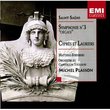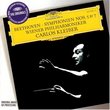| All Artists: Gustav Mahler, Herbert von Karajan, Berlin Philharmonic Orchestra Title: Mahler: Symphony No. 5 / Karajan, Berliner Philharmoniker Members Wishing: 0 Total Copies: 1 Label: Deutsche Grammophon Release Date: 8/13/1996 Genre: Classical Styles: Historical Periods, Modern, 20th, & 21st Century, Symphonies Number of Discs: 1 SwapaCD Credits: 1 UPC: 028944745023 |
Search - Gustav Mahler, Herbert von Karajan, Berlin Philharmonic Orchestra :: Mahler: Symphony No. 5 / Karajan, Berliner Philharmoniker
 | Gustav Mahler, Herbert von Karajan, Berlin Philharmonic Orchestra Mahler: Symphony No. 5 / Karajan, Berliner Philharmoniker Genre: Classical
![header=[] body=[This CD is available to be requested as disc only.]](/images/attributes/disc.png?v=430e6b0a) ![header=[] body=[This CD is available to be requested with the disc and back insert.]](/images/attributes/disc_back.png?v=430e6b0a) ![header=[] body=[This CD is unavailable to be requested with the disc and front insert at this time.]](/images/attributes/greyed_disc_front.png?v=430e6b0a) ![header=[] body=[This CD is unavailable to be requested with the disc, front and back inserts at this time.]](/images/attributes/greyed_disc_front_back.png?v=430e6b0a) |
Larger Image |
CD DetailsSimilarly Requested CDs |
CD ReviewsA performance of white-hot intensity. Jack Burt | Maine | 11/19/1998 (5 out of 5 stars) "Herbert von Karajan came to Mahler in a round-about way. His affinity with Richard Strauss and Anton Bruckner was life-long. Mahler he came to only after exploring the Second Viennese School of Schoenberg, Berg and Webern. Released in the mid-seventies this, his first Mahler recording is extraordinary. The performance has an intensity and recklessness to it that is not found in any of Karajan's other recordings. Also, it is the only Mahler Symphony recorded by Karajan abd the BPO in the Jesus Christus Kirche and not in the Berlin Philharmonie. This brings a presence and warmth to the recorded sound not achieved by the engineers until much later in the Philharmonie. The horrific opening of the work is a case in point. It is rough almost to the point of losing control. Critics of Karajans supposed lack of intensity and emotional committment would be well served to study this recording. Karajan went on to make other great Mahler recordings, but none ever with such abandon again." Among The Best, & Quite Different In Tone From Its Peers Record Collector | Mons, Belgium | 04/14/2004 (5 out of 5 stars) "Karajan's detractors have called his music-making bloodless, over-refined, glutinous; certain of HvK's dubious associations in early manhood have evoked harsher invective about his character--"reptilian," for instance. Yes, his recorded testament is uneven, but given its range how could it be otherwise? So are those of Toscanini, Beecham, & Stokowski, to name but a few whose legacies span several decades. This recording gives the lie to the canard that HvK was a passionless control-freak. While I do not agree with another Amazon reviewer that HvK lets the orchestra get away from him in the peroration of the last movement, this performance does have an unbuttoned quality that this conductor seldom displayed: in the second movement, one can actually hear HvK crooning a la Sir John Barbirolli as the music surges towards a climax! The Berlin Philharmonic is caught at its early 70's peak, with some nice portamenti by the strings (even if the 12"-Adagietto is too slow). All in all, tho' this is completely different in conception & orchestral sound from the others, it belongs in the same company as the Mahler #5's of Walter (Sony), Barbirolli (EMI), & Haitink (the concert performance preserved in the Philips Christmas Matinee set of Mahler symphonies with the Concertgebouw, available on-line from Kuijper Klassiek in Holland: www.kuijperklassiek.nl)." Mahler remolds the symphonic form... ewomack | MN USA | 10/21/2005 (5 out of 5 stars) "Mahler, with his fifth symphony, stands the notion of "classical" symphony completely on its head. The fourth symphony was just the beginning. Here, instead of emphasizing the ending (a "grand finale") he emphasizes the middle. What's called "the longest scherzo in history" provides the pivotal point of three massive sections (subdivided into 5 movements). And instead of a simple "ka-bang" of an ending (like his second and third symphonies provided) he throws in some comedy. Not only that, Mahler found himself fresh out of "Wayfarer" songs by 1901 and thus turned his attention more to non-vocal music. Mix that with some very forward looking dissonant flourishes and it becomes clearer why some historians refer to this as Mahler's first truly modern symphony. Some even consider this work the dividing line between nineteenth and twentieth century music.
Karajan and the Berlin Philharmonic really beef and blast this one out. His focus on power and bombast may hide the more comedic aspects of the work, but those who prefer a romantic interpretation of Mahler will find it in this 1973 recording in droves. The explosions in the first movement violently spring forth. The shrieks that begin the second movement crawl up spinal cords. And the stacatto blasts near the end of the massive scherzo may cause techtonic movement. Lastly, the two "big endings", at the close of the second and fifth movements, blast like cannons to more than emphasize the connections between the sections (though the final one gets swept up in some subsequent humorous passages). They're really hard to miss. Some may find the interpretation overbearing or overwrought. Others may bathe in the charged romanticism. Karajan and company really shine in the justly famous Adagietto. The version on this CD is truly heartbreaking. Its final Tristan chord stretches to very near breaking point before resolving like a sumptuous exhale after a long held breath. Many listeners discover the entire symphony through this movement alone. Some consider it Mahler's love letter to his future wife Alma (whom he married in 1902 during the same time this symphony took shape). Those new to Mahler's fifth face some big challenges. At first the third pivotal movement may seem utterly impenetrable. The music changes with such dynamic ferocity to seem fleeting or hopelessly evasive. But the real treasures of the work lay here. Only through repeated listenings do the subtleties and mind boggling Escher-esque intertwining of themes emerge. And the structure of the entire piece really weighs on the intuitive notion of a piece of music and especially the idea of a symphonic work. At no time before had a composer emphasized the middle rather than the ending of a work. It's really something quite new for those steeped in the classical tradition. Mahler never makes it easy, but the effort really pays off once the piece begins to click. Plus Mahler quotes famous works as well as his own. The beginning trumpet riff echoes Beethoven's famous fifth symphony while also mirroring a passage from the first movement of Mahler's own fourth symphony. Shades of Wagner and Verdi also shine through the cracks. Mahler wanted to capture the full experience of the symphonic tradition and nothing, even history, was left out. So here in the fifth Mahler creates yet another world. It's open to multiple interpretations and so thematically thick that perhaps no two people experience it in the same way. And this remains an indelible part of Mahler's musical legacy. Karajan and friends offer one rather blustering interpretation of this amazing work. The adagietto is worth the listen alone." |

 Track Listings (5) - Disc #1
Track Listings (5) - Disc #1








